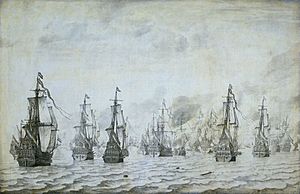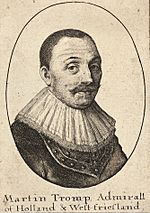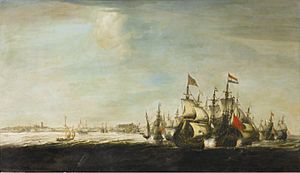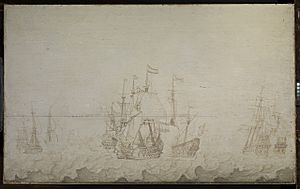Action of 18 February 1639 facts for kids
Quick facts for kids Action of 18 February 1639 |
|||||||
|---|---|---|---|---|---|---|---|
| Part of the Eighty Years' War | |||||||
 The naval battle against the Spaniards near Dunkerque, 18 february 1639. Oil and ink on canvas by Willem van de Velde the Elder. |
|||||||
|
|||||||
| Belligerents | |||||||
| Commanders and leaders | |||||||
| Maarten Tromp | Miguel de Horna | ||||||
| Strength | |||||||
| 12 warships |
12 galleons Other source gives figures of 6 galleons and 2 frigates |
||||||
| Casualties and losses | |||||||
| No ships lost 1,700 captured, killed, or wounded ? |
3 ships lost min. 600 killed and wounded 1,600 men killed or wounded, 250 captured |
||||||
The action of 18 February 1639 was a naval battle that happened off the coast of Dunkirk. This fight was part of the Eighty Years' War, a long conflict between the Dutch and Spain. The battle involved a Dutch fleet led by Admiral Maarten Tromp and a Spanish fleet from Dunkirk, commanded by Miguel de Horna.
Horna's mission was to join another Spanish fleet. He also needed to transport about 2,000 soldiers to Spain. These soldiers were called Walloons and were needed to defend Spain. Horna tried to leave Dunkirk, but Admiral Tromp's Dutch ships were waiting. A fierce battle lasted for four hours. Horna was forced to retreat back into Dunkirk. He lost two of his large ships, called galleons, and another got stuck. Even though Tromp stopped Horna, many of his own ships were badly damaged. This forced the Dutch Admiral to stop blocking the port. After repairing his ships, Horna was able to complete his mission.
Why the Battle Happened
By 1639, Spain's navy was struggling in its war against the Dutch Republic. Many of Spain's main warships were busy in other parts of the world. Also, Dutch privateer ships were blocking Spanish treasure fleets. These treasure fleets carried important goods and money.
France had also joined the war against Spain. This led to a major loss for Spain's northern fleet. It was destroyed by a larger French fleet in the Battle of Guetaria. This battle also damaged Spain's shipbuilding areas. Only about 20 large Spanish ships were still ready for battle.
In January 1639, a Spanish leader named Olivares ordered a large fleet to gather in Galicia. This fleet was meant to carry soldiers and money to the Spanish Netherlands. Admiral Antonio de Oquendo was put in charge of this fleet. Since land routes were blocked by French and Dutch armies, supplies had to go by sea.
The Spanish Squadron of Dunkirk, led by Admiral Miguel de Horna, was ordered to join Oquendo's fleet. About 2,000 Walloon soldiers were put on Horna's ships. They were being sent to Spain to help defend against a possible French attack.
When the Dutch government heard about these plans, they sent Admiral Maarten Tromp. He was ordered to stop the Dunkirk ships from leaving. Tromp arrived off Dunkirk on February 17 with 12 warships. The military governor of Dunkirk, the Marquis of Fuentes, told Horna to sail immediately. He believed Horna's fleet was strong enough.
On February 18, Horna's convoy left the port at dawn. It included 12 galleons, 3 smaller ships called pinnaces, and 5 transport ships. Spanish reports from that time say many of Horna's ships got stuck near Mardyck. This left Admiral Horna with only 6 galleons and 2 smaller frigates.
The Battle Begins
The Spanish squadron sailed out from Mardyck around 8 PM. There was very little wind. At the same time, Tromp's 12 Dutch ships were anchored nearby. They quickly set sail and moved west. The Dutch ships met the Spanish squadron between Mardyck and Gravelines.
As soon as the two fleets were close enough, a fierce battle began. It lasted for about four hours. Tromp's main ship, the Amelia, was damaged. The Dutch Admiral had to stop twice to fix holes in his ship.
Since the wind was not helping his ships, Horna moved towards the Fort of Mardyck. He was looking for protection from the fort's cannons. Tromp followed him closely. He attacked the Spanish vice-flagship. This ship lost its steering and its rudder was shot off. It eventually got stuck on the sand. Its crew set it on fire after saving some supplies.
Two other Spanish galleons, commanded by Captains Mény and Petit, were captured. Each of these ships had 34 cannons. Horna was forced to retreat. The Dutch estimated that the Spanish fleet lost about 1,600 men killed or wounded. Spanish reports said around 400 were lost. About 250 prisoners were taken from the two captured galleons.
What Happened Next
The Marquis of Fuentes was blamed for the failure. He even put De Horna and his Vice-Admiral Matthys Rombout in prison for a short time. However, he soon gave them back their jobs. In less than a month, Horna's squadron was repaired and ready to sail again.
Horna left Dunkirk on March 12. The port was no longer blocked by the Dutch. His squadron safely reached A Coruña, capturing some commercial ships along the way. Meanwhile, Tromp and his captains were honored with gold chains and medals.
However, unlike the Spanish, Tromp could not repair his ships quickly. When he finally set sail on March 15, it was too late to stop De Horna. He only had 4 ships with him. From a strategic point of view, De Horna had completed his mission. Tromp's two-year effort to block Dunkirk had failed to stop the Spanish ships. De Horna added seven galleons to Oquendo's fleet. These ships were the San José, San Vicente, San Gedeón, Salvador, San Juan Evangelista, San Martín, and San Carlos.
See also
 In Spanish: Batalla de Dunkerque (1639) para niños
In Spanish: Batalla de Dunkerque (1639) para niños





